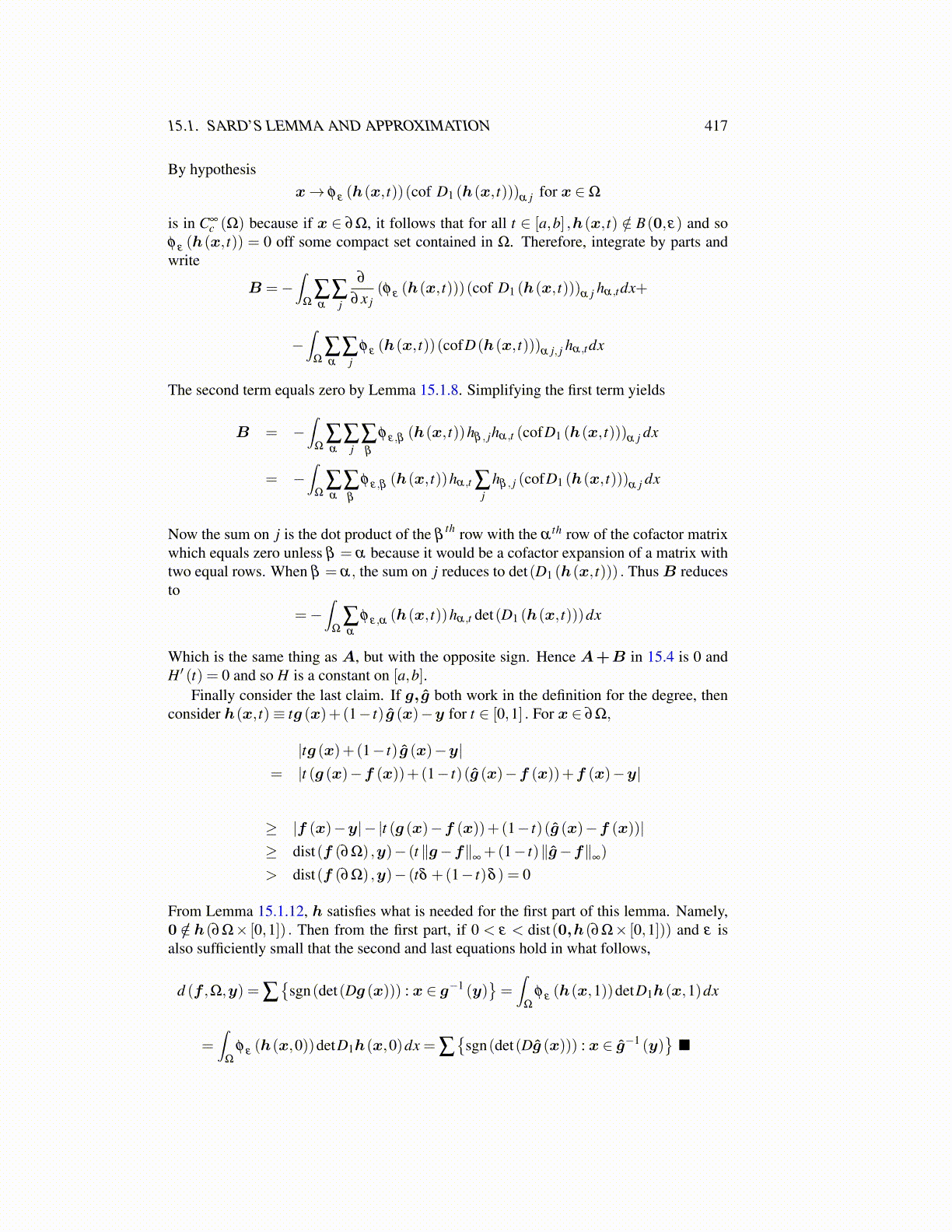
15.1. SARD’S LEMMA AND APPROXIMATION 417
By hypothesisx→ φ ε (h(x, t))(cof D1 (h(x, t)))α j for x ∈Ω
is in C∞c (Ω) because if x ∈ ∂Ω, it follows that for all t ∈ [a,b] ,h(x, t) /∈ B(0,ε) and so
φ ε (h(x, t)) = 0 off some compact set contained in Ω. Therefore, integrate by parts andwrite
B =−∫
Ω∑α
∑j
∂
∂x j(φ ε (h(x, t)))(cof D1 (h(x, t)))α j hα,tdx+
−∫
Ω∑α
∑j
φ ε (h(x, t))(cofD(h(x, t)))α j, j hα,tdx
The second term equals zero by Lemma 15.1.8. Simplifying the first term yields
B = −∫
Ω∑α
∑j∑β
φ ε,β (h(x, t))hβ , jhα,t (cofD1 (h(x, t)))α j dx
= −∫
Ω∑α
∑β
φ ε,β (h(x, t))hα,t ∑j
hβ , j (cofD1 (h(x, t)))α j dx
Now the sum on j is the dot product of the βth row with the α th row of the cofactor matrix
which equals zero unless β = α because it would be a cofactor expansion of a matrix withtwo equal rows. When β = α, the sum on j reduces to det(D1 (h(x, t))) . ThusB reducesto
=−∫
Ω∑α
φ ε,α (h(x, t))hα,t det(D1 (h(x, t)))dx
Which is the same thing as A, but with the opposite sign. Hence A+B in 15.4 is 0 andH ′ (t) = 0 and so H is a constant on [a,b].
Finally consider the last claim. If g, ĝ both work in the definition for the degree, thenconsider h(x, t)≡ tg (x)+(1− t) ĝ (x)−y for t ∈ [0,1] . For x ∈ ∂Ω,
|tg (x)+(1− t) ĝ (x)−y|= |t (g (x)−f (x))+(1− t)(ĝ (x)−f (x))+f (x)−y|
≥ |f (x)−y|− |t (g (x)−f (x))+(1− t)(ĝ (x)−f (x))|≥ dist(f (∂Ω) ,y)− (t ∥g−f∥
∞+(1− t)∥ĝ−f∥
∞)
> dist(f (∂Ω) ,y)− (tδ +(1− t)δ ) = 0
From Lemma 15.1.12, h satisfies what is needed for the first part of this lemma. Namely,0 /∈ h(∂Ω× [0,1]) . Then from the first part, if 0 < ε < dist(0,h(∂Ω× [0,1])) and ε isalso sufficiently small that the second and last equations hold in what follows,
d (f ,Ω,y) = ∑{
sgn(det(Dg (x))) : x ∈ g−1 (y)}=∫
Ω
φ ε (h(x,1))detD1h(x,1)dx
=∫
Ω
φ ε (h(x,0))detD1h(x,0)dx = ∑{
sgn(det(Dĝ (x))) : x ∈ ĝ−1 (y)}■